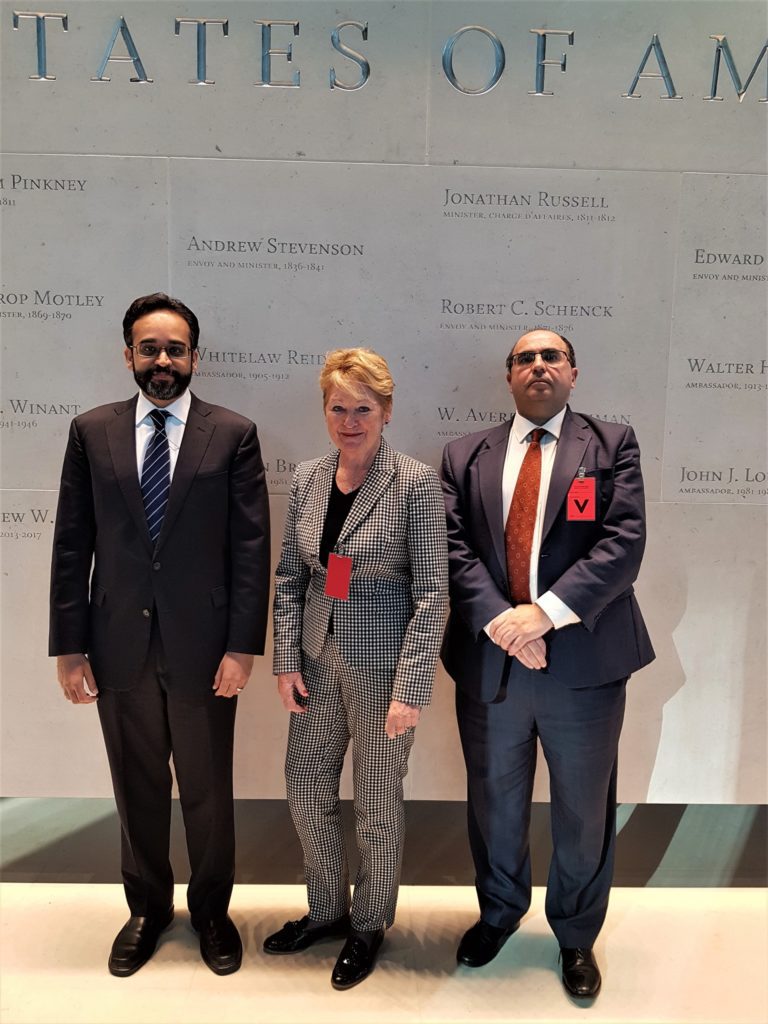

At the request of USA IP “Czar” Vishal Amin, Dids Macdonald, OBE and Nick Kounoupias visited the American Embassy in London to brief Mr Amin and his team on UK design and intellectual property issues in the context of post-Brexit trade negotiations and also for him to better understand the challenges facing the UK design community.
UK design output is significant, currently contributing £85.2 billion to the UK’s GDP and employing 1.5 million people in design and design skills but the majority are lone, micro and SME. This is a growing sector and, potentially, a positive international calling card for the UK in future trade deals. The UK is a world leader in design capability.
Talks continued outlining the current IP challenges:
Background information
“Vishal Amin is an American attorney and government official who currently serves as Intellectual Property Enforcement Coordinator. This position, sometimes referred to as “IP Czar”, was created by an act of Congress in 2008 in order to help the U.S. government combat online piracy.[1][2][3] Prior to assuming his current role, Amin was senior counsel on the House Judiciary Committee. Vishal J. Amin is located in the executive office of the president.
The Trump administration takes the US intellectual property enforcement coordinator’s role in new directions, building on past administrations but trying to address ways it has not been effective in the past, according to the annual report of the coordinator, released yesterday.
The 200-page annual report of the IPEC to Congress is available here [pdf]. The report details actions taken by the Trump administration in the last year, ranging from numerous meetings with governments, private sector, and others, changes to rulemaking, enforcement actions and legal cases including a World Trade Organization challenge against China, educational and training activities worldwide, hearings and more. It mentions coordination with the World Intellectual Property Organization, and also discusses efforts to fight cybercrime, including on the Dark Web. The report further describes law enforcement activities at the local, regional and national level, as well as across federal agencies. The Departments of Justice and Commerce have joined together to set up now five regional IP Law Enforcement Coordinators, training local judges, lawyers, and law enforcement. The five offices are in Hong Kong; Sao Paulo, Brazil; Bucharest, Romania; Bangkok, Thailand; and Abuja, Nigeria”.
“WASHINGTON — When President Trump and President Xi Jinping of China sat down to talk trade last year at the Group of 20 summit meeting, their negotiations were framed by a highly charged topic: The White House’s insistence that China routinely steals American technology and intellectual property.
The Trump administration has repeatedly levied accusations of theft at China, invoking a term that offends the Chinese. Mr. Trump regularly says that China has “ripped off” the United States. Recently, Vice President Mike Pence said China’s security agencies had “masterminded the wholesale theft of American technology,” and Larry Kudlow, Mr. Trump’s top economic adviser, said in a G-20 preview that “issues of intellectual property theft must be solved.”
The language employed by the Trump administration sometimes lumps together distinct but related issues, such as the trade deficit the United States runs with China, technology transfer deals negotiated by American companies and espionage intended to advance China’s economic rise”.
Spread the Word

Latest News





Newsletter Sign-Up
| Cookie | Duration | Description |
|---|---|---|
| cookielawinfo-checkbox-analytics | 11 months | This cookie is set by GDPR Cookie Consent plugin. The cookie is used to store the user consent for the cookies in the category "Analytics". |
| cookielawinfo-checkbox-functional | 11 months | The cookie is set by GDPR cookie consent to record the user consent for the cookies in the category "Functional". |
| cookielawinfo-checkbox-necessary | 11 months | This cookie is set by GDPR Cookie Consent plugin. The cookies is used to store the user consent for the cookies in the category "Necessary". |
| cookielawinfo-checkbox-others | 11 months | This cookie is set by GDPR Cookie Consent plugin. The cookie is used to store the user consent for the cookies in the category "Other. |
| cookielawinfo-checkbox-performance | 11 months | This cookie is set by GDPR Cookie Consent plugin. The cookie is used to store the user consent for the cookies in the category "Performance". |
| viewed_cookie_policy | 11 months | The cookie is set by the GDPR Cookie Consent plugin and is used to store whether or not user has consented to the use of cookies. It does not store any personal data. |